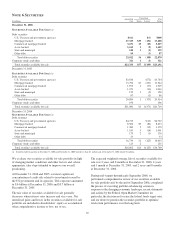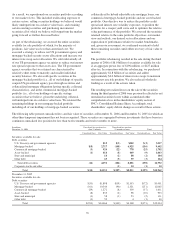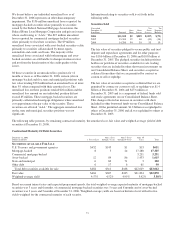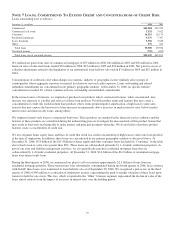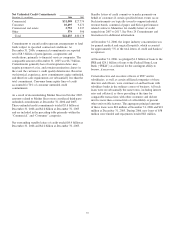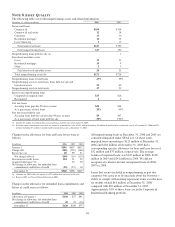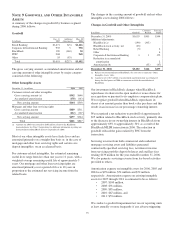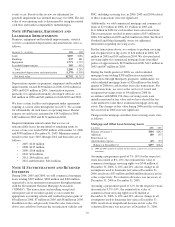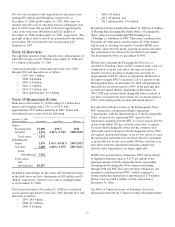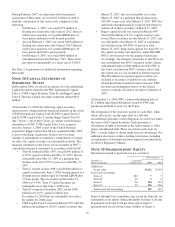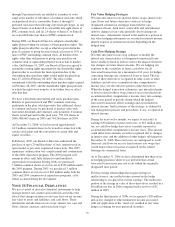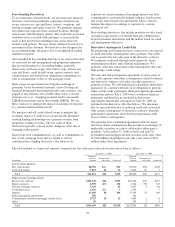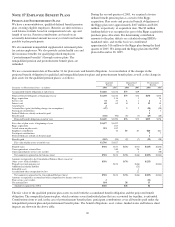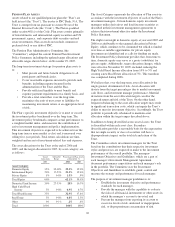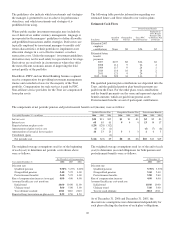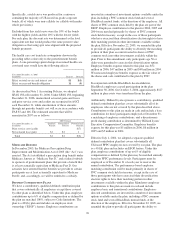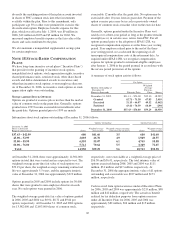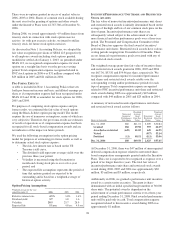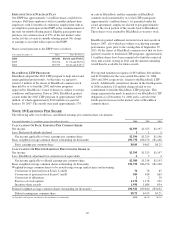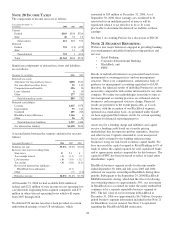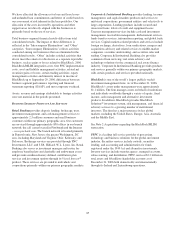PNC Bank 2006 Annual Report Download - page 109
Download and view the complete annual report
Please find page 109 of the 2006 PNC Bank annual report below. You can navigate through the pages in the report by either clicking on the pages listed below, or by using the keyword search tool below to find specific information within the annual report.through D preferred stock are entitled to a number of votes
equal to the number of full shares of common stock into which
such preferred stock is convertible. Series A through D
preferred stock have the following conversion privileges: (i) one
share of Series A or Series B is convertible into eight shares of
PNC common stock; and (ii) 2.4 shares of Series C or Series D
are convertible into four shares of PNC common stock.
During 2000, our Board of Directors adopted a shareholder
rights plan providing for issuance of share purchase rights. The
rights plan provided that, except as otherwise provided in the
plan, if a person or group becomes beneficial owner of 10% or
more of PNC outstanding common stock, all holders of the
rights, other than such person or group, may purchase our
common stock or equivalent preferred stock at half of market
value. On February 14, 2007, our Board of Directors agreed to
amend the existing rights agreement for the shareholder rights
plan in order to accelerate the final expiration date of the
outstanding share purchase rights issued under the plan from
May 25, 2010 to February 28, 2007. The effect of this
amendment is that the outstanding share purchase rights expired
on February 28, 2007, and the shareholder rights plan pursuant
to which the rights were issued is of no further force or effect
after that date.
We have a dividend reinvestment and stock purchase plan.
Holders of preferred stock and PNC common stock may
participate in the plan, which provides that additional shares
of common stock may be purchased at market value with
reinvested dividends and voluntary cash payments. Common
shares issued pursuant to this plan were: 535,394 shares in
2006, 688,665 shares in 2005 and 744,266 shares in 2004.
At December 31, 2006, we had reserved approximately
44.3 million common shares to be issued in connection with
certain stock plans and the conversion of certain debt and
equity securities.
In February 2005, our Board of Directors authorized the
purchase of up to 20 million shares of our common stock in
open market or privately negotiated transactions. The 2005
repurchase authorization was a replacement and continuation
of the 2004 repurchase program. The 2005 program will
remain in effect until fully utilized or until modified,
superseded or terminated. During 2006, we purchased
5 million common shares at a total cost of $354 million under
the 2005 program. During 2005, we purchased .5 million
common shares at a total cost of $26 million under both the
2005 and 2004 common stock repurchase programs, all of
which occurred during the first quarter.
N
OTE
16 F
INANCIAL
D
ERIVATIVES
We use a variety of derivative financial instruments to help
manage interest rate, market and credit risk and reduce the
effects that changes in interest rates may have on net income,
fair value of assets and liabilities, and cash flows. These
instruments include interest rate swaps, interest rate caps and
floors, futures contracts, and total return swaps.
Fair Value Hedging Strategies
We enter into interest rate and total return swaps, interest rate
caps, floors and futures derivative contracts to hedge
designated commercial mortgage loans held for sale,
commercial loans, bank notes, senior debt and subordinated
debt for changes in fair value primarily due to changes in
interest rates. Adjustments related to the ineffective portion of
fair value hedging instruments are recorded in interest income,
interest expense or noninterest income depending on the
hedged item.
Cash Flow Hedging Strategy
We enter into interest rate swap contracts to modify the
interest rate characteristics of designated commercial loans
from variable to fixed in order to reduce the impact of interest
rate changes on future interest income. We are hedging our
exposure to the variability of future cash flows for all
forecasted transactions for a maximum of 10 years for hedges
converting floating-rate commercial loans to fixed. The fair
value of these derivatives is reported in other assets or other
liabilities and offset in accumulated other comprehensive
income (loss) for the effective portion of the derivatives.
When the hedged transaction culminates, any unrealized gains
or losses related to these swap contracts are reclassified from
accumulated other comprehensive income (loss) into earnings
in the same period or periods during which the hedged
forecasted transaction affects earnings and are included in
interest income. Ineffectiveness of the strategy, as defined by
risk management policies and procedures, if any, is reported in
interest income.
During the next twelve months, we expect to reclassify to
earnings $30 million of pretax net losses, or $19 million after-
tax, on cash flow hedge derivatives currently reported in
accumulated other comprehensive income (loss). This amount
could differ from amounts actually recognized due to changes
in interest rates and the addition of other hedges subsequent to
December 31, 2006. These net losses are anticipated to result
from net cash flows on receive fixed interest rate swaps that
would impact interest income recognized on the related
floating rate commercial loans.
As of December 31, 2006 we have determined that there were
no hedging positions where it was probable that certain
forecasted transactions may not occur within the originally
designated time period.
For those hedge relationships that require testing for
ineffectiveness, any ineffectiveness present in the hedge
relationship is recognized in current earnings. The ineffective
portion of the change in value of these derivatives resulted in a
$4 million net loss in 2006 compared with a net loss of $3
million in 2005.
During the third quarter of 2006, we recognized a $20 million
pretax loss charged to other noninterest income associated
with our application of the “short-cut” method of fair value
hedge accounting for trust preferred securities.
99


